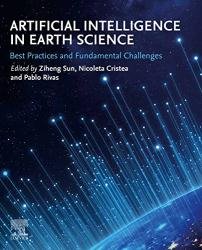 Название: Artificial Intelligence in Earth Science: Best Practices and Fundamental Challenges
Название: Artificial Intelligence in Earth Science: Best Practices and Fundamental ChallengesАвтор: Ziheng Sun, Nicoleta Cristea, Pablo Rivas
Издательство: Elsevier
Год: 2023
Страниц: 430
Язык: английский
Формат: pdf (true)
Размер: 42.9 MB
Artificial Intelligence in Earth Science: Best Practices and Fundamental Challenges provides a comprehensive, step-by-step guide to AI workflows for solving problems in Earth Science. The book focuses on the most challenging problems in applying AI in Earth system sciences, such as training data preparation, model selection, hyperparameter tuning, model structure optimization, spatiotemporal generalization, transforming model results into products, and explaining trained models. In addition, it provides full-stack workflow tutorials to help walk readers through the whole process, regardless of previous AI experience.
Artificial Intelligence (AI) technologies have been aggressively experimented with in Earth system sciences and attempted to solve these urgent problems and provide a solution for those ultimate challenges of humanity.
Deep Learning has become one of the most popular research areas and could almost be seen in every branch of Earth sciences today. The idea behind deep learning is based on adding more hidden layers to the neural network, using a series of methods to control the model regularization and balance between overfitting and underfitting. In every iteration, the difference is calculated and the back propagated (or back optimized by another algorithm) to adjust the weights on the connections between the neurons which could be located on two sequential layers or two nonsequential layers (ResNet, U-Net). Numerous networks deal with specific types of datasets. Convolutional neural networks are one of the most widely used models to learn patterns from images or n-dimensional gridded data, a common task in Earth system sciences. Most powerful neural networks of today are larger than those of even just a few years ago, such as GPT-3 (Generative Pre-trained Transformer 3) which has 96 layers with about 175 billion trainable parameters. Training the models takes a huge amount of com- puting hours and specialized hardware like GPU or TPU for greater benefits of parallelism to reduce overall time costs. Training big models on Earth scientific datasets could easily go up to hundreds of Terabytes or even Petabyte level could cause challenging problems such as running out of memory and or excessively long computation times.
The book tackles the complexity of Earth system problems in AI engineering, fully guiding geoscientists who are planning to implement AI in their daily work.
Provides practical, step-by-step guides for Earth Scientists who are interested in implementing AI techniques in their work
Features case studies to show real-world examples of techniques described in the book
Includes additional elements to help readers who are new to AI, including end-of-chapter, key concept bulleted lists that concisely cover key concepts in the chapter
Скачать Artificial Intelligence in Earth Science: Best Practices and Fundamental Challenges